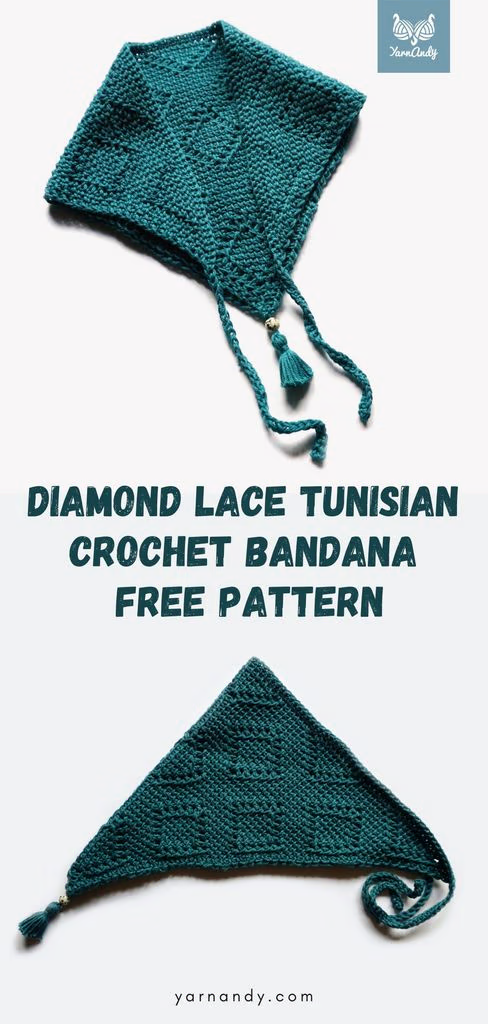Use this free bandana pattern to make a cute summer accessory with geometric diamond motifs. Follow the detailed instructions or the charts and have fun exploring Tunisian crochet lace.
Contents
About this diamond lace bandana pattern
This is an intermediate lace pattern triangle-shaped bandana with ties. It is built from the tip at the bottom and it grows with each row.
The size is variable and you can make it cover a larger or smaller area by changing the number of rows you work. The ties are practical and light.
It is made of light cotton yarn, which makes it ideal for wearing on the beach, in place of a hat.
The repeating lace diamond motifs can be continued for a larger head wrap.
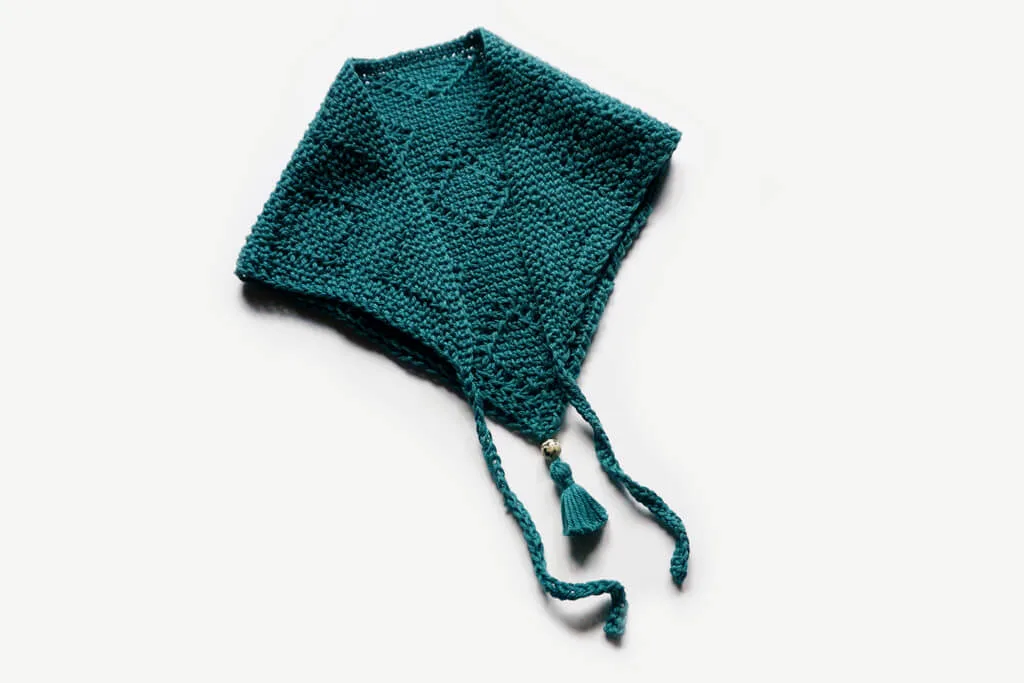
PDF versions of this Tunisian crochet bandana pattern
You can find the print-friendly PDF pattern here:
Size and measurements
When meeting gauge and working all rows in the pattern, the triangle measures 60 cm across the top and 28 cm in depth, due to the slight elasticity of the lace pattern.
Gauge
Gauge is not essential in this pattern, as you work to your desired measurements.
If you do want to work to the provided size, make a gauge swatch by following these instructions
Row 1. Ch 25, pick up 25 loops in the back bumps of the chains, R (26 loops)
Row 2. 24 Tss, Ls, R (26 loops)
Repeat Row 2 24 more times for a total of 26 rows.
Block the swatch by washing it and laying it flat to dry.
Measure a 10 by 10 cm (4″ by 4″) square in the middle of the swatch and count the stitches and rows.
18 stitches and 18 rows should measure 10 by 10 cm (4″ by 4″).
If you get fewer stitches and rows, go down a hook size (0.5 mm), if available, and make another swatch.
If you get more stitches and rows, go up a hook size (0.5 mm), if available, and make another swatch.
Repeat the swatching process until you reach the recommended gauge. Make a note of the hook size used.
Skill level
Intermediate – you will work with eyelets, increases, decreases, simple repeats of lace patterns. You need to be able to keep consistent tension in cotton yarn.
Observations
This is a Tunisian crochet pattern worked flat, which means you always work on the right side of the fabric (the side that will be towards the outside).
Each row of symbols in the chart is independent of the previous row. You read each row of the chart as if reading a row of instructions.
The chart includes special symbols that are not usual for Tunisian crochet, but are explained in the legend and the instructions accompanying the chart.
When you encounter an eyelet and need to make a Tss, insert the hook through the eyelet and draw up a loop.
After a YO, you don’t skip a stitch unless specifically instructed.
You can stop whenever you like and continue with the ties and binding off row to finish the bandana.
Stitch makers are useful for keeping track of stitch counts.
Repeats are shown in [square brackets].
At the end of each row, loop counts are shown in (round brackets), including the first and last loop, before starting the return pass.
After finishing the bandana, wash it and lay it flat to dry. Then press it with an iron, on the wrong side, to open up the lace and give it the triangle shape.
You can make a tassel to attach at the bottom. Attach it after washing and pressing the bandana.
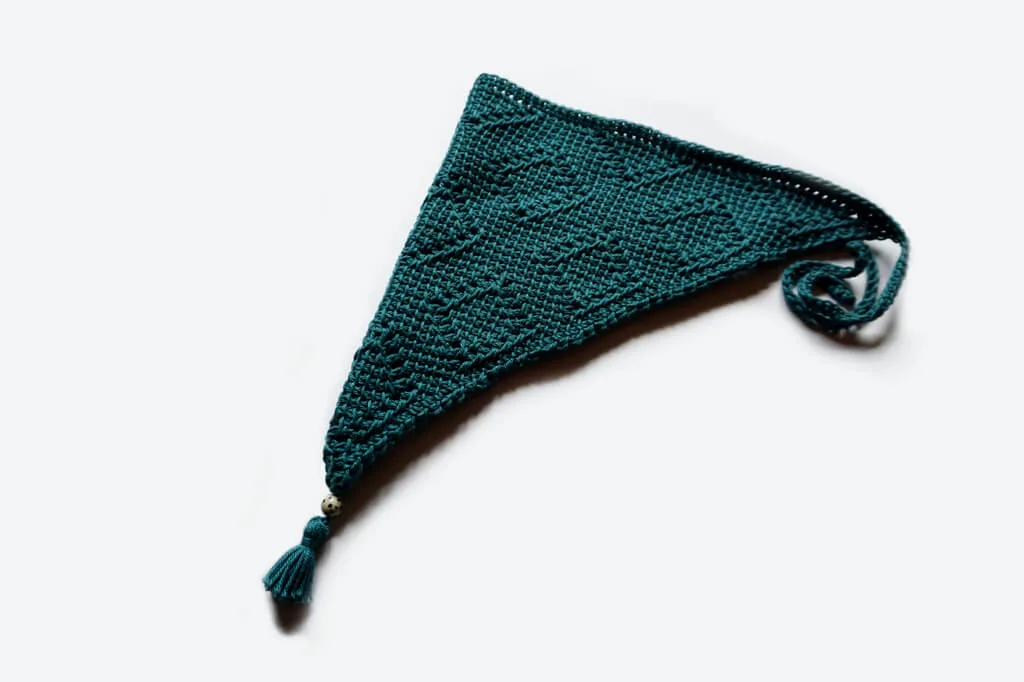
Notions
- Yarn. 40-50 g or 70-80 meters of size 2 cotton yarn at about 250-340 meters per 100 grams – for example 8/4 cotton yarn;
- Hook -Tunisian crochet hook with cable or straight, 5 mm or hook size that gets you gauge; 3.5 mm regular crochet hook for binding off and ties;
- Tapestry needle, scissors, tape measure;
- Optional. stitch markers;
- Tools for blocking (iron with steam or other steamer), blocking mats and pins.
Sample made using Hobbii Simple Cotton 8/4 yarn.
Examples of yarn that works with this pattern: Paintbox Yarns Cotton 4 ply, Scheepjes Catona, Schachenmayr Catania, Rowan Summerlite 4 Ply, DMC Natura Just Cotton, Schachenmayr Organic Cotton.
Any of the colors in these yarns would work well with this pattern. Choose a light color to show off the lace.
Abbreviations
- BO – Bind off;
- Ch – Chain;
- Fs – First stitch;
- Ls – Last stitch: insert hook behind the two vertical bars at the end of the row, YO and pull up a loop;
- R – Regular return pass: Ch 1, Rep [YO and pull through 2 loops on hook] until 1 loop is left;
- Rep – Repeat;
- Sc – single crochet (US) or double crochet (UK);
- Sk – Skip;
- Sl St(s) – Slip stitch(es);
- St(s) – Stitch(es);
- Tfs – Tunisian full stitch: insert the hook in the space before the next St, YO and pull up a loop;
- Tps – Tunisian purl stitch: YU, insert the hook under the vertical bar of the next St, YO and pull up a loop;
- Tss – Tunisian simple stitch: insert the hook under the vertical bar of the next St, YO and pull up a loop;
- Tss2Tog – Tunisian simple stitch 2 together: insert the hook under the front vertical bars of the next 2 Sts, YO and pull up a loop;
- Tss3Tog – Tunisian simple stitch 3 together: insert the hook under the front vertical bars of the next 3 Sts, YO and pull up a loop;
- YO – Yarn over;
- YU – Yarn under: bring the yarn under and to the front of the hook.
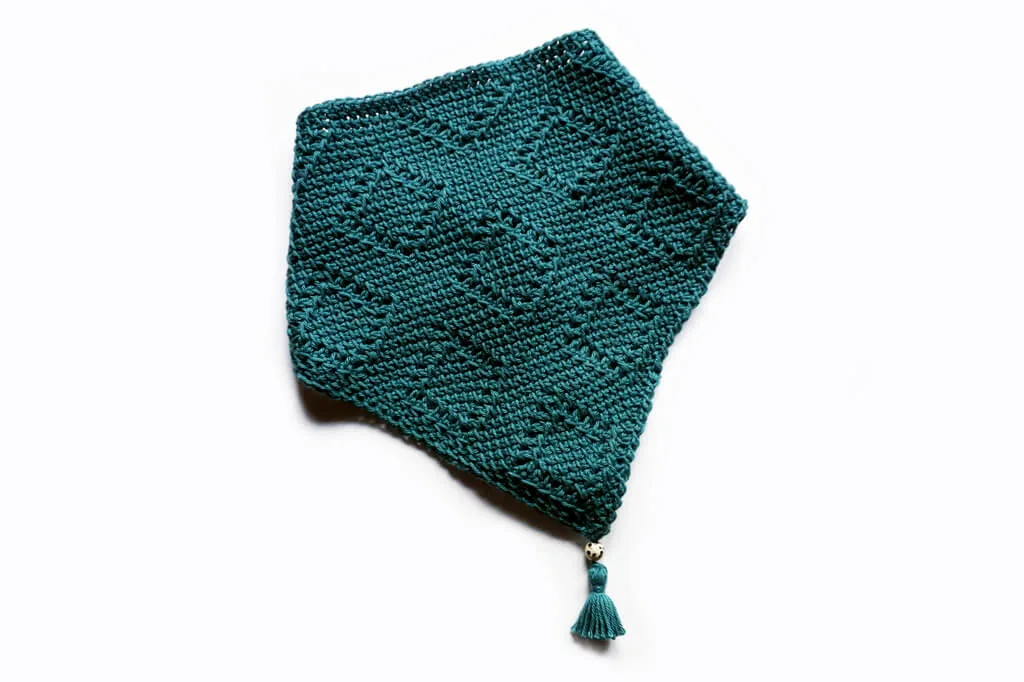
Instructions
Start with a slip knot on the Tunisian crochet hook.
Row 1. Ch 2, pick up 2 loops in back bumps of the chains, R (3 loops)
Row 2. Tfs, Tps, Tfs, Ls, R (5 loops)
Row 3. Tfs, Tps, Tss, Tps, Tfs, Ls, R (7 loops)
Row 4. Tfs, Tps, 3 Tss, Tps, Tfs, Ls, R (9 loops)
Row 5. Tfs, Tps, 2 Tss, YO, Tss2Tog, Tss, Tps, Tfs, Ls, R (11 loops)
Row 6. Tfs, Tps, Tss, Tss2Tog, YO, Tss, YO, Tss2Tog, Tss, Tps, Tfs, Ls, R (13 loops)
Row 7. Tfs, Tps, Tss, Tss2Tog, YO, 3 Tss, YO, Tss2Tog, Tss, Tps, Tfs, Ls, R (15 loops)
Row 8. Tfs, Tps, Tss, Tss2Tog, YO, 5 Tss, YO, Tss2Tog, Tss, Tps, Tfs, Ls, R (17 loops)
Row 9. Tfs, Tps, Tss, Tss2Tog, YO, 7 Tss, YO, Tss2Tog, Tss, Tps, Tfs, Ls, R (19 loops)
Row 10. Tfs, Tps, Tss, Tss2Tog, YO, 9 Tss, YO, Tss2Tog, Tss, Tps, Tfs, Ls, R (21 loops)
Row 11. Tfs, Tps, 4 Tss, YO, Tss2Tog, 5 Tss, Tss2Tog, YO, 4 Tss, Tps, Tfs, Ls, R (23 loops)
Row 12. Tfs, Tps, 6 Tss, YO, Tss2Tog, 3 Tss, Tss2Tog, YO, 6 Tss, Tps, Tfs, Ls, R (25 loops)
Row 13. Tfs, Tps, 8 Tss, YO, Tss2Tog, Tss, Tss2Tog, YO, 8 Tss, Tps, Tfs, Ls, R (27 loops)
Row 14. Tfs, Tps, Tss, Tss2Tog, YO, 7 Tss, YO, Tss3Tog, YO, 7 Tss, YO, Tss2Tog, Tss, Tps, Tfs, Ls, R (29 loops)
Row 15. Tfs, Tps, Tss, Tss2Tog, YO, Tss, YO, Tss2Tog, 6 Tss, (YO, Sk 1), 6 Tss, Tss2Tog, YO, Tss, YO, Tss2Tog, Tss, Tps, Tfs, Ls, R (31 loops)
Row 16. Tfs, Tps, Tss, Tss2Tog, YO, 3 Tss, YO, Tss2Tog, 11 Tss, Tss2Tog, YO, 3 Tss, YO, Tss2Tog, Tss, Tps, Tfs, Ls, R (33 loops)
Row 17. Tfs, Tps, Tss, Tss2Tog, YO, 5 Tss, YO, Tss2Tog, 9 Tss, Tss2Tog, YO, 5 Tss, YO, Tss2Tog, Tss, Tps, Tfs, Ls, R (35 loops)
Row 18. Tfs, Tps, Tss, Tss2Tog, YO, 7 Tss, YO, Tss2Tog, 7 Tss, Tss2Tog, YO, 7 Tss, YO, Tss2Tog, Tss, Tps, Tfs, Ls, R (37 loops)
Row 19. Tfs, Tps, Tss, Tss2Tog, YO, 9 Tss, YO, Tss2Tog, 5 Tss, Tss2Tog, YO, 9 Tss, YO, Tss2Tog, Tss, Tps, Tfs, Ls, R (39 loops)
Row 20. Tfs, Tps, 4 Tss, YO, Tss2Tog, 5 Tss, Tss2Tog, YO, 9 Tss, YO, Tss2Tog, 5 Tss, Tss2Tog, YO, 4 Tss, Tps, Tfs, Ls, R (41 loops)
Row 21. Tfs, Tps, 6 Tss, YO, Tss2Tog, 3 Tss, Tss2Tog, YO, 11 Tss, YO, Tss2Tog, 3 Tss, Tss2Tog, YO, 6 Tss, Tps, Tfs, Ls, R (43 loops)
Row 22. Tfs, Tps, 8 Tss, YO, Tss2Tog, Tss, Tss2Tog, YO, 13 Tss, YO, Tss2Tog, Tss, Tss2Tog, YO, 8 Tss, Tps, Tfs, Ls, R (45 loops)
Row 23. Tfs, Tps, Rep [Tss, Tss2Tog, YO, 7 Tss, YO, Tss3Tog, YO, 5 Tss] 2 times, 2 Tss, YO, Tss2Tog, Tss, Tps, Tfs, Ls, R (47 loops)
Row 24. Tfs, Tps, Rep [Tss, Tss2Tog, YO, Tss, YO, Tss2Tog, 6 Tss, (YO, Sk 1), 5 Tss] 2 times, Tss, Tss2Tog, YO, Tss, YO, Tss2Tog, Tss, Tps, Tfs, Ls, R (49 loops)
Row 25. Tfs, Tps, Rep [Tss, Tss2Tog, YO, 3 Tss, YO, Tss2Tog, 10 Tss] 2 times, Tss, Tss2Tog, YO, 3 Tss, YO, Tss2Tog, Tss, Tps, Tfs, Ls, R (51 loops)
Row 26. Tfs, Tps, Rep [Tss, Tss2Tog, YO, 5 Tss, YO, Tss2Tog, 8 Tss] 2 times, Tss, Tss2Tog, YO, 5 Tss, YO, Tss2Tog, Tss, Tps, Tfs, Ls, R (53 loops)
Row 27. Tfs, Tps, Rep [Tss, Tss2Tog, YO, 7 Tss, YO, Tss2Tog, 6 Tss] 2 times, Tss, Tss2Tog, YO, 7 Tss, YO, Tss2Tog, Tss, Tps, Tfs, Ls, R (55 loops)
Row 28. Tfs, Tps, Rep [Tss, Tss2Tog, YO, 9 Tss, YO, Tss2Tog, 4 Tss] 2 times, Tss, Tss2Tog, YO, 9 Tss, YO, Tss2Tog, Tss, Tps, Tfs, Ls, R (57 loops)
Row 29. Tfs, Tps, 4 Tss, Rep [YO, Tss2Tog, 5 Tss, Tss2Tog, YO, 9 Tss] 2 times, YO, Tss2Tog, 5 Tss, Tss2Tog, YO, 4 Tss, Tps, Tfs, Ls, R (59 loops)
Row 30. Tfs, Tps, 6 Tss, Rep [YO, Tss2Tog, 3 Tss, Tss2Tog, YO, 11 Tss] 2 times, YO, Tss2Tog, 3 Tss, Tss2Tog, YO, 6 Tss, Tps, Tfs, Ls, R (61 loops)
Row 31. Tfs, Tps, 8 Tss, Rep [YO, Tss2Tog, Tss, Tss2Tog, YO, 13 Tss] 2 times, YO, Tss2Tog, Tss, Tss2Tog, YO, 8 Tss, Tps, Tfs, Ls, R (63 loops)
Row 32. Tfs, Tps, Rep [Tss, Tss2Tog, YO, 7 Tss, YO, Tss3Tog, YO, 5 Tss] 2 times, 2 Tss, YO, Tss2Tog, 6 Tss, YO, Tss3Tog, YO, 7 Tss, YO, Tss2Tog, Tss, Tps, Tfs, Ls, R (65 loops)
Row 33. Tfs, Tps, Rep [Tss, Tss2Tog, YO, Tss, YO, Tss2Tog, 6 Tss, (YO, Sk 1), 5 Tss] 3 times, Tss, Tss2Tog, YO, Tss, YO, Tss2Tog, Tss, Tps, Tfs, Ls, R (67 loops)
Row 34. Tfs, Tps, Rep [Tss, Tss2Tog, YO, 3 Tss, YO, Tss2Tog, 10 Tss] 3 times, Tss, Tss2Tog, YO, 3 Tss, YO, Tss2Tog, Tss, Tps, Tfs, Ls, R (69 loops)
Row 35. Tfs, Tps, Rep [Tss, Tss2Tog, YO, 5 Tss, YO, Tss2Tog, 8 Tss] 3 times, Tss, Tss2Tog, YO, 5 Tss, YO, Tss2Tog, Tss, Tps, Tfs, Ls, R (71 loops)
Row 36. Tfs, Tps, Rep [Tss, Tss2Tog, YO, 7 Tss, YO, Tss2Tog, 6 Tss] 3 times, Tss, Tss2Tog, YO, 7 Tss, YO, Tss2Tog, Tss, Tps, Tfs, Ls, R (73 loops)
Row 37. Tfs, Tps, Tss, Rep [Tss2Tog, YO, 9 Tss, YO, Tss2Tog, 5 Tss] 3 times, Tss2Tog, YO, 9 Tss, YO, Tss2Tog, Tss, Tps, Tfs, Ls, R (75 loops)
Row 38. Tfs, Tps, 4 Tss, Rep [YO, Tss2Tog, 5 Tss, Tss2Tog, YO, 9 Tss] 3 times, YO, Tss2Tog, 5 Tss, Tss2Tog, YO, 4 Tss, Tps, Tfs, Ls, R (77 loops)
Row 39. Tfs, Tps, 6 Tss, Rep [YO, Tss2Tog, 3 Tss, Tss2Tog, YO, 11 Tss] 3 times, YO, Tss2Tog, 3 Tss, Tss2Tog, YO, 6 Tss, Tps, Tfs, Ls, R (79 loops)
Row 40. Tfs, Tps, 8 Tss, Rep [YO, Tss2Tog, Tss, Tss2Tog, YO, 13 Tss] 3 times, YO, Tss2Tog, Tss, Tss2Tog, YO, 8 Tss, Tps, Tfs, Ls, R (81 loops)
Row 41. Tfs, Tps, Rep [Tss, Tss2Tog, YO, 7 Tss, YO, Tss3Tog, YO, 5 Tss] 2 times, Rep [2 Tss, YO, Tss2Tog, 6 Tss, YO, Tss3Tog, YO, 5 Tss] 2 times, 2 Tss, YO, Tss2Tog, Tss, Tps, Tfs, Ls, R (83 loops)
Row 42. Tfs, Tps, Rep [Tss, Tss2Tog, YO, Tss, YO, Tss2Tog, 6 Tss, (YO, Sk 1), 5 Tss] 4 times, Tss, Tss2Tog, YO, Tss, YO, Tss2Tog, Tss, Tps, Tfs, Ls, R (85 loops)
Row 43. Tfs, Tps, Rep [Tss, Tss2Tog, YO, 3 Tss, YO, Tss2Tog, 10 Tss] 4 times, Tss, Tss2Tog, YO, 3 Tss, YO, Tss2Tog, Tss, Tps, Tfs, Ls, R (87 loops)
Row 44. Tfs, Tps, Rep [Tss, Tss2Tog, YO, 5 Tss, YO, Tss2Tog, 8 Tss] 4 times, Tss, Tss2Tog, YO, 5 Tss, YO, Tss2Tog, Tss, Tps, Tfs, Ls, R (89 loops)
Row 45. Tfs, Tps, Rep [Tss, Tss2Tog, YO, 7 Tss, YO, Tss2Tog, 6 Tss] 4 times, Tss, Tss2Tog, YO, 7 Tss, YO, Tss2Tog, Tss, Tps, Tfs, Ls, R (91 loops)
Row 46. Tfs, Tps, Rep [Tss, Tss2Tog, YO, 9 Tss, YO, Tss2Tog, 4 Tss] 4 times, Tss, Tss2Tog, YO, 9 Tss, YO, Tss2Tog, Tss, Tps, Tfs, Ls, R (93 loops)
Row 47. Tfs, Tps, 4 Tss, Rep [YO, Tss2Tog, 5 Tss, Tss2Tog, YO, 9 Tss] 4 times, YO, Tss2Tog, 5 Tss, Tss2Tog, YO, 4 Tss, Tps, Tfs, Ls, R (95 loops)
Binding off
Ch 31, Sk 1, make Sc in back bumps of chains.
Bind off with Sc as if to make Tss. Ch 31, turn, Sk 1, make Sc in back bumps of chains OR make 30 foundation Sc.
Weave in all tails or use the tail at the beginning to tie a tassel.
Here’s how to make a cute tassel. Make it smaller and with fewer strands than in the video.
Charts for this Tunisian crochet lace bandana
How to use the charts
This pattern can be made by following along with the instructions, following the chart or both at the same time.
You can save and print these charts, to assemble them to form the large chart, or just follow the stitches on the same row over the 3 charts for each row.
Follow the stitches for each row individually. The full chart shows the intended shape and layout of the final project, but when working from the chart you should only look at the stitches on the current row.
Start working from the bottom and reading each row from right to left, even if you are left handed.
The return pass rows are represented on the chart with the symbol R. The first loop (which you don’t work with in this pattern) is represented with the symbol F.
Everything else is represented in the legend.
Overall chart
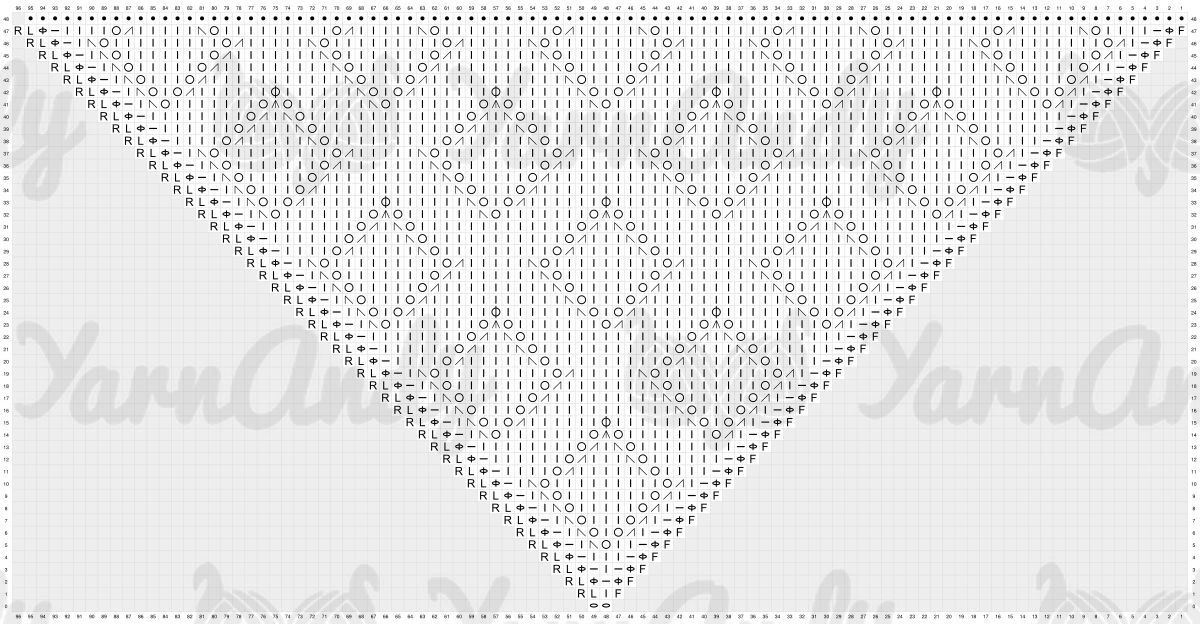
Legend
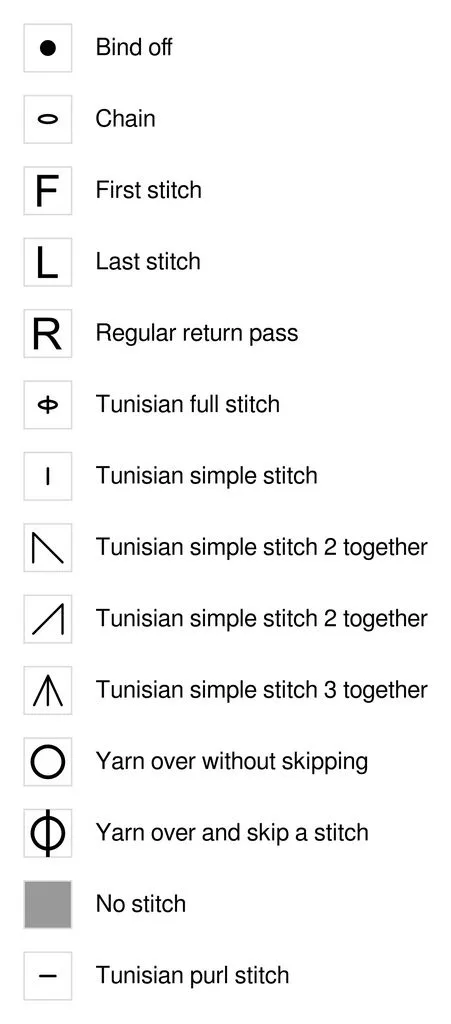
Where to find the PDF pattern
You can find the print-friendly PDF pattern here:
Final remarks
I hope that you’ll have fun with the pattern and try out other Tunisian crochet patterns that I’ve put out so far.
If you’re interested in more bandana patterns, see below a list of all of them. If you want to know when I publish more, sign up to my email updates here.
Also if you want to see what this pattern looks like knit.
Hugs,
Andrea
